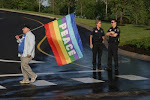
Another Side of Afghanistan: Visiting the Grave of A National Hero by Steve Clemens. March 22, 2011
Panjshir is considered to be one of the most beautiful provinces in Afghanistan (although in fairness to the Afghan Youth Peace Volunteers from Bamiyan, many Afghans we met say Bamiyan is the most scenic). Although this valley about an hour and a half north of the capital city, Kabul saw some of the most intense fighting during the time of the Soviet occupation in the 1980s and then in the civil war that ensued in the early 1990s between various mujaheddin factions, it has remained one of the few relatively peaceful spots in the country since the fall of the Taliban in 2001.
However, the drive to get there is a sobering one. En route one passes the detritus of the most recent empire to have foundered here in the land of the western Hindu Kush Mountains. Afghanistan has seen many wars over its long history including invasions by Genghis Khan and Alexander the Great. More recently it has been know as a place where “empires go to die.” It was part of what was known as “the Great Game”, the sparring chess piece of the competition between the Russian and British empires in the late 1800s and early 1900s, gaining it’s independence from Britain after the Third Afghan-Anglo War in 1919 but the treaty ending the war and establishing modern-day Afghanistan contained the seeds of further regional tension by splitting the majority Pashtun ethnic group in two – placing half in what is now Pakistan and the other half in Afghanistan by the geographic fiction known as the Durand Line. Most of the Taliban, both the Afghan version and the Pakistan version are ethnically Pashtun with Pashto as their language rather than Dari, the other official language of Afghanistan, a version of Persian or Farsi.
Most of the Pashtuns dominate the populations of the southern and eastern portions of Afghanistan but the Panjshir Province is overwhelmingly Tajik, the second-largest ethic group in the country. Panjshir only became a province in 2004 at the direction of President Karzai in an attempt to honor Ahmed Shah Massoud, the military leader who Karzai proclaimed as a “national hero”. [Some of my new Afghan friends told me “there is no ‘national hero’ in Afghanistan” claiming that ethnic rivalry prevents one from representing the whole nation – so one could say he is at least a Tajik hero. They claim Karzai’s primary motivation was to try to secure Tajik votes for his election.]

Massoud led the Afghan forces that helped defeat the Soviet forces as they attempted to come up the Panjshir valley and later was the head of what was called the “Northern Alliance”, a collection of the fighters under other war lords attempting to resist control of the nation by the Pakistan-supported Taliban in the 1990s. Two suicide bombers posing as journalists two days before Sept. 11, 2001 assassinated him – some say as a “present” from Bin Laden to Mullah Omar, the Taliban leader. Wherever one goes in the Panjshir Valley, you see photos in homage to “the Lion of the Panjshir”. Halfway up the valley, on a rise overlooking the Panjshir River and his hometown of Bazarak, there is a memorial built for Massoud with his grave at the center of it. Plans are underway to build a museum and a hotel at the site. He is identified as a “martyr” for his people.
However, before we reached this scenic overlook, just before passing the road leading to the sprawling Baghram Air Base (with its notorious prison), we saw a huge field, an outdoor museum of sorts, of dozens

if not hundreds of destroyed or abandoned, rusting Soviet tanks. Next to this “monument” of defeat is the site of one of numerous U.S. military bases we passed. Ironically, it is situated on the site of a former Soviet base, where the last empire “went to die” and our empire, full of hubris and historical blinders, thinks it will avoid the same fate. Like Abu Ghraib prison in Iraq, why is our military choosing the same sites as previous oppressors to use in their own occupations? Are we that culturally ignorant? Baghram Air Base was the center operating base for the Soviets in their brutal war and now we blithely follow them.
As military convoys pass us on the road, it is instructive that the caravans are led by Afghan troops in smaller vehicles, followed by the American troops in vehicles that are considerably larger and more heavily armored.

It is a startling statement (to me) of whose lives are more valued.
This day trip was a pleasant interlude from the crowded, dusty, capital city where all of our other activities have been concentrated, primarily for security reasons. Returning to Kabul in mid-afternoon was first hair-raising – due to the driving style of the Afghan Logistics driver (as well as all the other drivers on the road and he didn’t even wear his seat belt!) – and then sobering. Just as we approached the city limits, we saw a refugee camp by the highway.

The collection of tents and makeshift shelters stretched on for several blocks in both directions. Others in our delegation who previously visited a different camp said it is one of many here in Kabul, with many, many others across the border in Pakistan. We’ve been told that many have “lived” in these camps for at least 3-4 years wondering if they’ll ever be able to return to their home areas – and when they do, can they ever reclaim their land and homes? This is the human face of war that all of our politicians seem to avoid.




No comments:
Post a Comment